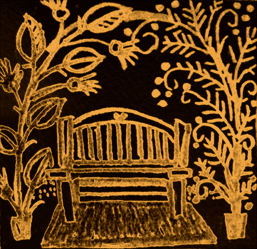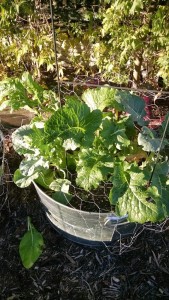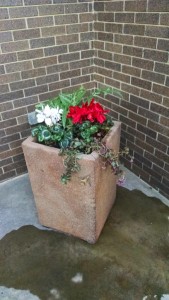This week I worked on my own container garden, thinning the kale, mustard and chard to make room for a few plants to truly take off. I added azomite as well as worm castings before planting.
Azomite provides multiple trace minerals (they say as many as 70!) that have been leached from our soils over the years. That’s one reason our food is less nutritious than it was 50 years ago.
And it’s another reason to garden organically. What goes into the soil, goes into the plants, and goes into our bodies. Our bodies also need these trace minerals. Okay, I’ll step off my soapbox now.
I did have a wonderful greens supper the night of the thinning, cooking my mustard and kale greens with olive oil and garlic.
Another fun activity this week was planting a client’s ornamental pots, strewn about his pool area as well as his front entrance. It’s a modern house with a magnificent view.
He wanted color for the winter. I chose cyclamens (rose, pink, red) as well as crotons (interesting veins of red, deep green, light green and gold), moneywort for ground cover and dripping from pots, cardoon (beautifully spiky for a variety of texture; this plant will grow larger), alyssum (for fragrance and some low level white contrast) and sedum (this variety has a purplish green leaf and is a ground cover that is also dripping over the edge of the pot).
I even threw in a couple of chard plants! Those will also grow larger, although they are hidden now. I just can’t resist putting in an edible or two – maybe I should have also added some purple cabbage? Well, too late now. Since I’ve been focused on edibles, this was a fun variation.
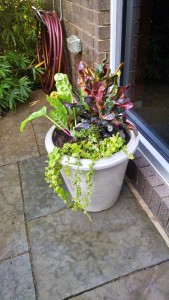 AND THEN, I gave a talk on straw bale gardening to a local gardening group. The advantage of straw bales is that they are mobile. They are also temporary and are ideal for renters who want to garden but don’t want to tear up a landlord’s yard. Another use is if the only spot for a sunny garden is on the patio or the driveway!
AND THEN, I gave a talk on straw bale gardening to a local gardening group. The advantage of straw bales is that they are mobile. They are also temporary and are ideal for renters who want to garden but don’t want to tear up a landlord’s yard. Another use is if the only spot for a sunny garden is on the patio or the driveway! I found Joel Karsten’s book (see my page on My Favorite Reference Books) on straw bale gardening particularly interesting, but decided to use an organic program to condition the bales rather than the one he uses.
I’m on my second set of straw bales. The first ones worked really well, and by the end of the summer the tomatoes had completely covered the bales – you had to really look closely and pull tomato vines aside to see the bales. But they required little watering and the interior was nice and composted.
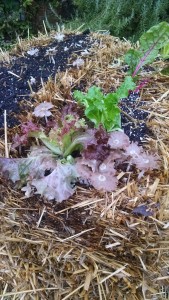 The second set I’m working on is a bit slower going because of the cooler temperatures. I’ve used a different set of organic materials. It takes time – the plants are slow at first, but when they hit the composted interior….WOW! … they take off. Here’s a picture of what my current set looked like on October 10. Note the mushrooms that have appeared like stars among the transplanted greens. That means that the bales are “cooking” with microbes.
The second set I’m working on is a bit slower going because of the cooler temperatures. I’ve used a different set of organic materials. It takes time – the plants are slow at first, but when they hit the composted interior….WOW! … they take off. Here’s a picture of what my current set looked like on October 10. Note the mushrooms that have appeared like stars among the transplanted greens. That means that the bales are “cooking” with microbes.